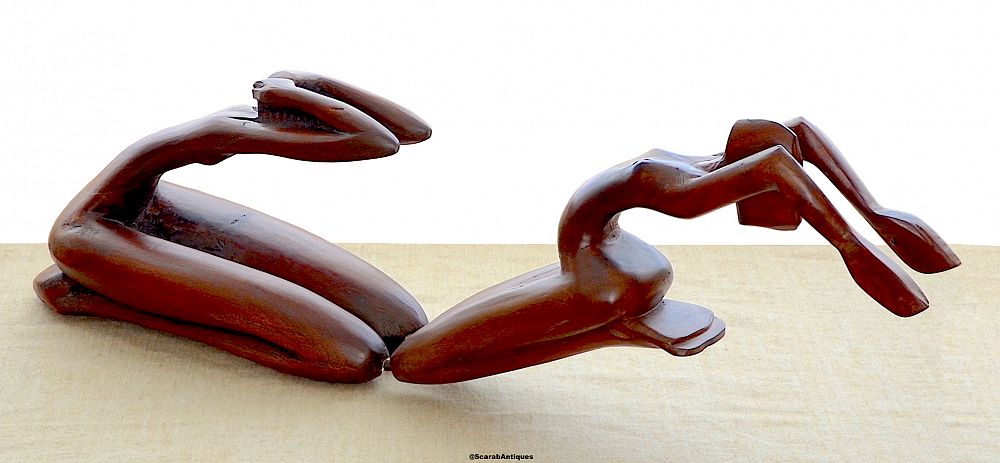Renowned for his distinctive style, Zimbabwean-born sculptor Shepherd Ndudzo has made a remarkable impact in the world of art. His signature pieces, known for their fluid and elongated forms, are a sight to behold. Carved from the purest white rock, these sculptures often depict black figures in a state of motion – dancing, praying, or reaching out in a powerful display of human connection and emotion.
Ndudzo’s recent exhibition at the FNB Joburg Art Fair in South Africa, presented by Botswana’s Ora Laopi contemporary art gallery and research project, was a vivid showcase of his talent. Here, his evocative figurative sculptures, meticulously carved from marble, granite, and ironwood, were displayed alongside his abstract wooden creations, notably the ‘Seed’ series.
Born in 1978, Shepherd Ndudzo has become an emblem of Botswana’s rich sculptural heritage, where he currently resides and creates his art. This exhibition was not only a testament to his artistic prowess but also a tribute to his father, Barnabas Ndudzo, a master sculptor renowned for his realistic, often life-sized works.
In a captivating documentary produced by the gallery, Shepherd shares insights into his artistic journey, mentored by his father. His works, he explains, are more than just art; they are narratives of migration and poignant reflections of his family’s story, woven seamlessly into each creation. Through his sculptures, Shepherd Ndudzo continues to define and celebrate the untold histories of southern African art.
The captivating story of Shepherd Ndudzo’s art is deeply interwoven with the cultural and artistic heritage of three neighboring nations in southern Africa: Zimbabwe, Botswana, and South Africa. This tri-nation narrative, rich in shared traditions, teaching methodologies, and a history marked by colonial influence and artistic revolutions, forms a crucial part of my PhD research on Zimbabwean art.
In my analysis, understanding Ndudzo’s transnational journey is key to fully appreciating his work. It’s a journey that highlights the fluidity and reinvention of art traditions across borders.
The Kekana School Legacy The roots of Ndudzo’s artistic lineage trace back to the Kekana School of Art and Craft. Established in the 1960s in Zimbabwe by the South African sculptor Job Patja Kekana, this institution was a rarity for its time, being founded by a black artist amidst a landscape dominated by white missionaries and expatriates. Kekana, an alumnus of the Grace Dieu Mission Diocesan Training College—a hub for influential black modernists like Gerard Sekoto and Ernest Mancoba—imbued the school with a spirit of modernism, a movement characterized by innovation and socio-political engagement.
Shepherd Ndudzo’s connection to the Kekana School came through his father, Barnabas, who was a pupil of Kekana. This link was further solidified when Shepherd himself attended St Faith’s High School, where he briefly encountered Kekana, his father’s mentor.
Learning from a Master Shepherd’s primary education in sculpture came from observing and assisting his father, Barnabas, who, like Kekana and his other students, predominantly created realistic statues and busts. This hands-on apprenticeship with his father shaped Shepherd’s approach and style in sculpture.
The Controversy of Artistic Categorization Zimbabwe’s renowned “Shona sculpture” tradition, known for its handmade tools and intricate carvings from serpentinite rocks, was somewhat misrepresented by Frank McEwen, a UK-born artist, teacher, and curator. As the founding director of the Rhodes National Gallery (now the National Gallery of Zimbabwe), McEwen played a pivotal role in promoting Zimbabwe’s abstract stone sculpture. However, his broad categorization often overlooked the diversity of ethnic backgrounds and styles, inadvertently marginalizing artists working with materials like wood and those creating realistic works, especially those at missionary workshops.
This intricate backdrop of artistic evolution, marked by both collaboration and conflict, is essential to understanding the depth and breadth of Shepherd Ndudzo’s work. His sculptures are not just physical forms but are imbued with the rich, complex history of southern African art.


